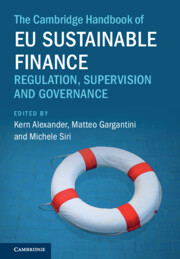Book contents
- The Cambridge Handbook of EU Sustainable Finance
- The Cambridge Handbook of EU Sustainable Finance
- Copyright page
- Contents
- Figures
- Tables
- Contributors
- Preface
- Acknowledgements
- Part I Introduction
- Part II Ethics and Sustainability in Corporate Law, Corporate Governance and Conduct
- 3 Firm Value versus Social Value
- 4 The Hardening of Corporate ESG
- 5 Stakeholder Engagement
- 6 Bank Governance and Sustainability
- 7 Risk Culture and Sustainability
- 8 Conduct Risk as a Possible Approach for Enhancing Awareness and Management of ESG-Related Risks
- 9 Sustainability and Executive Compensation
- Part III Integrating Sustainability in Financial Markets Regulation
- Part IV Ensuring Financial Stability and Sustainability
- Part V Financial Innovation and Sustainability
- Index
- References
7 - Risk Culture and Sustainability
from Part II - Ethics and Sustainability in Corporate Law, Corporate Governance and Conduct
Published online by Cambridge University Press: 30 January 2025
- The Cambridge Handbook of EU Sustainable Finance
- The Cambridge Handbook of EU Sustainable Finance
- Copyright page
- Contents
- Figures
- Tables
- Contributors
- Preface
- Acknowledgements
- Part I Introduction
- Part II Ethics and Sustainability in Corporate Law, Corporate Governance and Conduct
- 3 Firm Value versus Social Value
- 4 The Hardening of Corporate ESG
- 5 Stakeholder Engagement
- 6 Bank Governance and Sustainability
- 7 Risk Culture and Sustainability
- 8 Conduct Risk as a Possible Approach for Enhancing Awareness and Management of ESG-Related Risks
- 9 Sustainability and Executive Compensation
- Part III Integrating Sustainability in Financial Markets Regulation
- Part IV Ensuring Financial Stability and Sustainability
- Part V Financial Innovation and Sustainability
- Index
- References
Summary
This chapter focusses on environmental sustainability and provides a better understanding of the corporate governance levers that can direct behaviours towards environmental goals. We explore the relationship between risk culture and board members’ intention to adopt pro-environment strategies (PES) through individual beliefs. These factors, according to Ajzen’s theory of planned behaviour (ATPB), refer to what is convenient to do to achieve expected findings (behavioural beliefs), what should be done as required by regulators and induced by stakeholders’ pressure (normative beliefs) and the conviction of possessing skills, resources and opportunities to perform a specific behaviour (control beliefs). According to ATPB, behavioural beliefs, normative beliefs and control beliefs represent, in turn, predictors of an individual’s attitudes, subjective norms and perceived control beliefs. All these variables affect the intention to perform a behaviour and, in this case, to adopt pro-environmental strategies. The research analyses data obtained from a survey of 120 Italian board members, using a partial least square methodology to test the relationship between individual risk culture and beliefs, attitudes and norms and, finally, intention to adopt PES. Our findings add to previous work on the role of risk culture and provide a new theoretical perspective to guide green policy and changes aimed at increasing environmental sustainability.
Keywords
- Type
- Chapter
- Information
- The Cambridge Handbook of EU Sustainable FinanceRegulation, Supervision and Governance, pp. 154 - 186Publisher: Cambridge University PressPrint publication year: 2025

